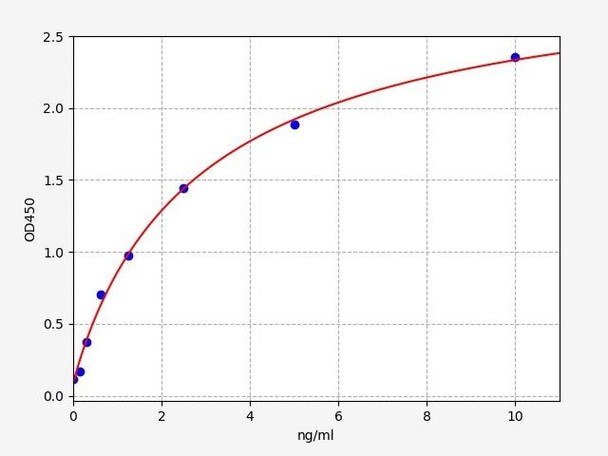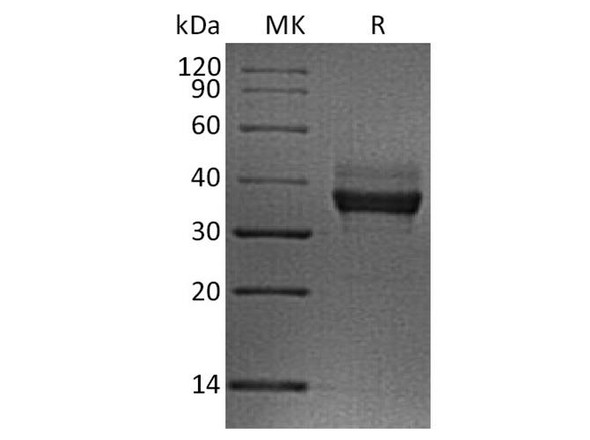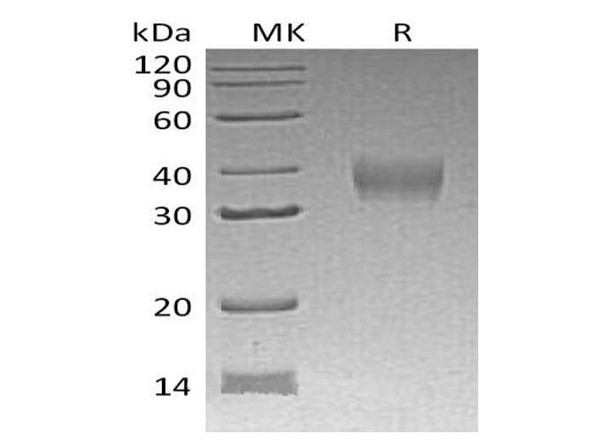Human LILRB4 / CD85k / ILT3 ELISA Kit
- SKU:
- HUFI01980
- Product Type:
- ELISA Kit
- Size:
- 96 Assays
- Uniprot:
- Q8NHJ6
- Sensitivity:
- 0.094ng/ml
- Range:
- 0.156-10ng/ml
- ELISA Type:
- Sandwich
- Synonyms:
- LILRB4, CD85k, HM18, ILT3, LIR5, CD85 antigen-like family member K, CD85k, CD85k antigen, ILT-3, ILT3CD85K, leukocyte immunoglobulin-like receptor, subfamily B, with TM and ITIM domains, LIR5LILRB5, LIR-5subfamily B, member 4
- Reactivity:
- Human
- Research Area:
- Immunology
Description
Human LILRB4/CD85k/ILT3 ELISA Kit
The Human LILRB4 (CD85k/ILT3) ELISA Kit is a powerful tool for quantifying levels of LILRB4 in human biological samples such as serum, plasma, and cell culture supernatants. This kit boasts a high level of sensitivity and specificity, ensuring accurate and dependable results for a variety of research purposes.LILRB4, also known as CD85k or ILT3, is a key immune checkpoint receptor that plays a critical role in regulating immune responses and modulating inflammation. Dysregulation of LILRB4 has been linked to autoimmune diseases, infectious diseases, and cancer, highlighting its importance as a potential therapeutic target and diagnostic marker.
By utilizing the Human LILRB4 (CD85k/ILT3) ELISA Kit, researchers can gain valuable insights into the role of LILRB4 in various disease states and aid in the development of novel treatment strategies. With its reliable performance and versatility, this kit is an essential tool for advancing research in immunology and beyond.
| Product Name: | Human LILRB4 / CD85k / ILT3 ELISA Kit |
| Product Code: | HUFI01980 |
| Size: | 96 Assays |
| Alias: | LILRB4, CD85k, HM18, ILT3, LIR5, CD85 antigen-like family member K, CD85k, CD85k antigen, ILT-3, ILT3CD85K, leukocyte immunoglobulin-like receptor, subfamily B, with TM and ITIM domains, LIR5LILRB5, LIR-5subfamily B, member 4 |
| Detection method: | Sandwich ELISA, Double Antibody |
| Application: | This immunoassay kit allows for the in vitro quantitative determination of Human LILRB4 concentrations in serum plasma and other biological fluids. |
| Sensitivity: | 0.094ng/ml |
| Range: | 0.156-10ng/ml |
| Storage: | 4°C for 6 months |
| Note: | For Research Use Only |
| Recovery: | Matrices listed below were spiked with certain level of Human LILRB4 and the recovery rates were calculated by comparing the measured value to the expected amount of Human LILRB4 in samples. | ||||||||||||||||
| |||||||||||||||||
| Linearity: | The linearity of the kit was assayed by testing samples spiked with appropriate concentration of Human LILRB4 and their serial dilutions. The results were demonstrated by the percentage of calculated concentration to the expected. | ||||||||||||||||
| |||||||||||||||||
| CV(%): | Intra-Assay: CV<8% Inter-Assay: CV<10% |
| Component | Quantity | Storage |
| ELISA Microplate (Dismountable) | 8×12 strips | 4°C for 6 months |
| Lyophilized Standard | 2 | 4°C/-20°C |
| Sample/Standard Dilution Buffer | 20ml | 4°C |
| Biotin-labeled Antibody(Concentrated) | 120ul | 4°C (Protect from light) |
| Antibody Dilution Buffer | 10ml | 4°C |
| HRP-Streptavidin Conjugate(SABC) | 120ul | 4°C (Protect from light) |
| SABC Dilution Buffer | 10ml | 4°C |
| TMB Substrate | 10ml | 4°C (Protect from light) |
| Stop Solution | 10ml | 4°C |
| Wash Buffer(25X) | 30ml | 4°C |
| Plate Sealer | 5 | - |
Other materials and equipment required:
- Microplate reader with 450 nm wavelength filter
- Multichannel Pipette, Pipette, microcentrifuge tubes and disposable pipette tips
- Incubator
- Deionized or distilled water
- Absorbent paper
- Buffer resevoir
| Uniprot | Q8NHJ6 |
| UniProt Protein Function: | LILRB4: Receptor for class I MHC antigens. Recognizes a broad spectrum of HLA-A, HLA-B, HLA-C and HLA-G alleles. Involved in the down-regulation of the immune response and the development of tolerance, e.g. towards transplants. Interferes with TNFRSF5- signaling and NF-kappa-B up-regulation. Inhibits receptor-mediated phosphorylation of cellular proteins and mobilization of intracellular calcium ions. 3 isoforms of the human protein are produced by alternative splicing. |
| UniProt Protein Details: | Protein type:Receptor, misc.; Membrane protein, integral Chromosomal Location of Human Ortholog: 19q13.4 Cellular Component: integral to membrane; plasma membrane Molecular Function:protein binding; receptor activity; antigen binding Biological Process: negative regulation of osteoclast differentiation; immune system process; signal transduction |
| NCBI Summary: | This gene is a member of the leukocyte immunoglobulin-like receptor (LIR) family, which is found in a gene cluster at chromosomal region 19q13.4. The encoded protein belongs to the subfamily B class of LIR receptors which contain two or four extracellular immunoglobulin domains, a transmembrane domain, and two to four cytoplasmic immunoreceptor tyrosine-based inhibitory motifs (ITIMs). The receptor is expressed on immune cells where it binds to MHC class I molecules on antigen-presenting cells and transduces a negative signal that inhibits stimulation of an immune response. The receptor can also function in antigen capture and presentation. It is thought to control inflammatory responses and cytotoxicity to help focus the immune response and limit autoreactivity. Multiple transcript variants encoding different isoforms have been found for this gene. [provided by RefSeq, Jul 2008] |
| UniProt Code: | Q8NHJ6 |
| NCBI GenInfo Identifier: | 322510117 |
| NCBI Gene ID: | 11006 |
| NCBI Accession: | Q8NHJ6.3 |
| UniProt Secondary Accession: | Q8NHJ6,O15468, O75021, Q6FGQ9, Q8N1C7, Q8NHL5, A8MVL8 |
| UniProt Related Accession: | Q8NHJ6 |
| Molecular Weight: | Calculated: 49 kDaObserved: 45-49kDa |
| NCBI Full Name: | Leukocyte immunoglobulin-like receptor subfamily B member 4 |
| NCBI Synonym Full Names: | leukocyte immunoglobulin-like receptor, subfamily B (with TM and ITIM domains), member 4 |
| NCBI Official Symbol: | LILRB4 |
| NCBI Official Synonym Symbols: | ILT3; LIR5; CD85K; ILT-3; LIR-5 |
| NCBI Protein Information: | leukocyte immunoglobulin-like receptor subfamily B member 4; immunoglobulin-like transcript 3; CD85 antigen-like family member K; monocyte inhibitory receptor HM18; leukocyte immunoglobulin-like receptor 5 |
| UniProt Protein Name: | Leukocyte immunoglobulin-like receptor subfamily B member 4 |
| UniProt Synonym Protein Names: | CD85 antigen-like family member K; Immunoglobulin-like transcript 3; ILT-3; Leukocyte immunoglobulin-like receptor 5; LIR-5; Monocyte inhibitory receptor HM18; CD_antigen: CD85k |
| Protein Family: | Leukocyte immunoglobulin-like receptor subfamily |
| UniProt Gene Name: | LILRB4 |
| UniProt Entry Name: | LIRB4_HUMAN |
*Note: Protocols are specific to each batch/lot. For the correct instructions please follow the protocol included in your kit.
Before adding to wells, equilibrate the SABC working solution and TMB substrate for at least 30 min at 37°C. When diluting samples and reagents, they must be mixed completely and evenly. It is recommended to plot a standard curve for each test.
| Step | Protocol |
| 1. | Set standard, test sample and control (zero) wells on the pre-coated plate respectively, and then, record their positions. It is recommended to measure each standard and sample in duplicate. Wash plate 2 times before adding standard, sample and control (zero) wells! |
| 2. | Aliquot 0.1ml standard solutions into the standard wells. |
| 3. | Add 0.1 ml of Sample / Standard dilution buffer into the control (zero) well. |
| 4. | Add 0.1 ml of properly diluted sample ( Human serum, plasma, tissue homogenates and other biological fluids.) into test sample wells. |
| 5. | Seal the plate with a cover and incubate at 37 °C for 90 min. |
| 6. | Remove the cover and discard the plate content, clap the plate on the absorbent filter papers or other absorbent material. Do NOT let the wells completely dry at any time. Wash plate X2. |
| 7. | Add 0.1 ml of Biotin- detection antibody working solution into the above wells (standard, test sample & zero wells). Add the solution at the bottom of each well without touching the side wall. |
| 8. | Seal the plate with a cover and incubate at 37°C for 60 min. |
| 9. | Remove the cover, and wash plate 3 times with Wash buffer. Let wash buffer rest in wells for 1 min between each wash. |
| 10. | Add 0.1 ml of SABC working solution into each well, cover the plate and incubate at 37°C for 30 min. |
| 11. | Remove the cover and wash plate 5 times with Wash buffer, and each time let the wash buffer stay in the wells for 1-2 min. |
| 12. | Add 90 µl of TMB substrate into each well, cover the plate and incubate at 37°C in dark within 10-20 min. (Note: This incubation time is for reference use only, the optimal time should be determined by end user.) And the shades of blue can be seen in the first 3-4 wells (with most concentrated standard solutions), the other wells show no obvious color. |
| 13. | Add 50 µl of Stop solution into each well and mix thoroughly. The color changes into yellow immediately. |
| 14. | Read the O.D. absorbance at 450 nm in a microplate reader immediately after adding the stop solution. |
When carrying out an ELISA assay it is important to prepare your samples in order to achieve the best possible results. Below we have a list of procedures for the preparation of samples for different sample types.
| Sample Type | Protocol |
| Serum | If using serum separator tubes, allow samples to clot for 30 minutes at room temperature. Centrifuge for 10 minutes at 1,000x g. Collect the serum fraction and assay promptly or aliquot and store the samples at -80°C. Avoid multiple freeze-thaw cycles. If serum separator tubes are not being used, allow samples to clot overnight at 2-8°C. Centrifuge for 10 minutes at 1,000x g. Remove serum and assay promptly or aliquot and store the samples at -80°C. Avoid multiple freeze-thaw cycles. |
| Plasma | Collect plasma using EDTA or heparin as an anticoagulant. Centrifuge samples at 4°C for 15 mins at 1000 × g within 30 mins of collection. Collect the plasma fraction and assay promptly or aliquot and store the samples at -80°C. Avoid multiple freeze-thaw cycles. Note: Over haemolysed samples are not suitable for use with this kit. |
| Urine & Cerebrospinal Fluid | Collect the urine (mid-stream) in a sterile container, centrifuge for 20 mins at 2000-3000 rpm. Remove supernatant and assay immediately. If any precipitation is detected, repeat the centrifugation step. A similar protocol can be used for cerebrospinal fluid. |
| Cell culture supernatant | Collect the cell culture media by pipette, followed by centrifugation at 4°C for 20 mins at 1500 rpm. Collect the clear supernatant and assay immediately. |
| Cell lysates | Solubilize cells in lysis buffer and allow to sit on ice for 30 minutes. Centrifuge tubes at 14,000 x g for 5 minutes to remove insoluble material. Aliquot the supernatant into a new tube and discard the remaining whole cell extract. Quantify total protein concentration using a total protein assay. Assay immediately or aliquot and store at ≤ -20 °C. |
| Tissue homogenates | The preparation of tissue homogenates will vary depending upon tissue type. Rinse tissue with 1X PBS to remove excess blood & homogenize in 20ml of 1X PBS (including protease inhibitors) and store overnight at ≤ -20°C. Two freeze-thaw cycles are required to break the cell membranes. To further disrupt the cell membranes you can sonicate the samples. Centrifuge homogenates for 5 mins at 5000xg. Remove the supernatant and assay immediately or aliquot and store at -20°C or -80°C. |
| Tissue lysates | Rinse tissue with PBS, cut into 1-2 mm pieces, and homogenize with a tissue homogenizer in PBS. Add an equal volume of RIPA buffer containing protease inhibitors and lyse tissues at room temperature for 30 minutes with gentle agitation. Centrifuge to remove debris. Quantify total protein concentration using a total protein assay. Assay immediately or aliquot and store at ≤ -20 °C. |
| Breast Milk | Collect milk samples and centrifuge at 10,000 x g for 60 min at 4°C. Aliquot the supernatant and assay. For long term use, store samples at -80°C. Minimize freeze/thaw cycles. |









